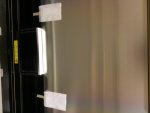I am sure someone has already posted about this, but I have not found the thread if they have. We have an ongoing problem with our autoloader not removing slips sheets.
Autoloader model is MA-L8800II. Platesetter is Screen PlateRite 8600S. We use Fuji plates, LHPJ. We have 40", 28", and small plates for duplicator and Jet press.
The error is almost always E130F, during the removing a paper, PH90 does not switch to off.
This happens constantly with the large 40 inch plates, and the small Jet plates. Not nearly as much with the 28 inch plates. (???)
We have had this problem for years and years, worse in the winter when the humidity is lower. But it seems particularly bad now. We have contacted Fuji about this, and the technician was just here and did a PM. The problem continues.
Fuji says to fan the plates, which we do, all the time. It does no good.
Humidity is 25%. I know it's low. We have tried a humidifier (Hydrofogger) in the past with RO water and it put white powder in the optics of the platesetter. Maybe we need to buy 50 gallons of distilled water every week, but keeping that going is not much better than dealing with the slip sheet problem in the first place.
Here is what frustrates me the most about this. You get the error, go to the rear of the autoloader, remove the sheet, re-initialize. That's all well and good. The big problem is you have to stand and wait for the machine to go to ready, then clear the error from the DTC computer. I really wish there was a way for the DTC to just pick up and resume when the platesetter is ready, without having to clear out the error. Because what happens is (everyone knows, I'm sure) you can start doing something else before resuming from the tiff catcher computer, and the platesetter sits idle.
So there is a lot of time lost and wasted because of this problem. I'm sure everyone experiences this issue, not just us. It doesn't do much good to have the autoloader if you constantly have to clear out slip sheet errors.
I remember the plates used to come with brown slip sheets, instead of white ones. I think the problem was less common with the brown slip sheets.
If anyone has some insight on this issue please let me know. For now we will keep fanning plates. I may call Fuji back but it probably won't do any good. As I said, the technician just did a PM last week, and the problem continues. Maybe I'm missing something? The other guys in prepress are getting pretty angry about this, and rightly so. Thanks ahead for any input on this matter.
Autoloader model is MA-L8800II. Platesetter is Screen PlateRite 8600S. We use Fuji plates, LHPJ. We have 40", 28", and small plates for duplicator and Jet press.
The error is almost always E130F, during the removing a paper, PH90 does not switch to off.
This happens constantly with the large 40 inch plates, and the small Jet plates. Not nearly as much with the 28 inch plates. (???)
We have had this problem for years and years, worse in the winter when the humidity is lower. But it seems particularly bad now. We have contacted Fuji about this, and the technician was just here and did a PM. The problem continues.
Fuji says to fan the plates, which we do, all the time. It does no good.
Humidity is 25%. I know it's low. We have tried a humidifier (Hydrofogger) in the past with RO water and it put white powder in the optics of the platesetter. Maybe we need to buy 50 gallons of distilled water every week, but keeping that going is not much better than dealing with the slip sheet problem in the first place.
Here is what frustrates me the most about this. You get the error, go to the rear of the autoloader, remove the sheet, re-initialize. That's all well and good. The big problem is you have to stand and wait for the machine to go to ready, then clear the error from the DTC computer. I really wish there was a way for the DTC to just pick up and resume when the platesetter is ready, without having to clear out the error. Because what happens is (everyone knows, I'm sure) you can start doing something else before resuming from the tiff catcher computer, and the platesetter sits idle.
So there is a lot of time lost and wasted because of this problem. I'm sure everyone experiences this issue, not just us. It doesn't do much good to have the autoloader if you constantly have to clear out slip sheet errors.
I remember the plates used to come with brown slip sheets, instead of white ones. I think the problem was less common with the brown slip sheets.
If anyone has some insight on this issue please let me know. For now we will keep fanning plates. I may call Fuji back but it probably won't do any good. As I said, the technician just did a PM last week, and the problem continues. Maybe I'm missing something? The other guys in prepress are getting pretty angry about this, and rightly so. Thanks ahead for any input on this matter.












